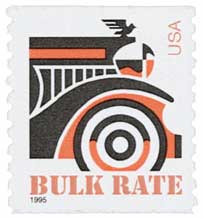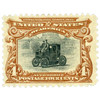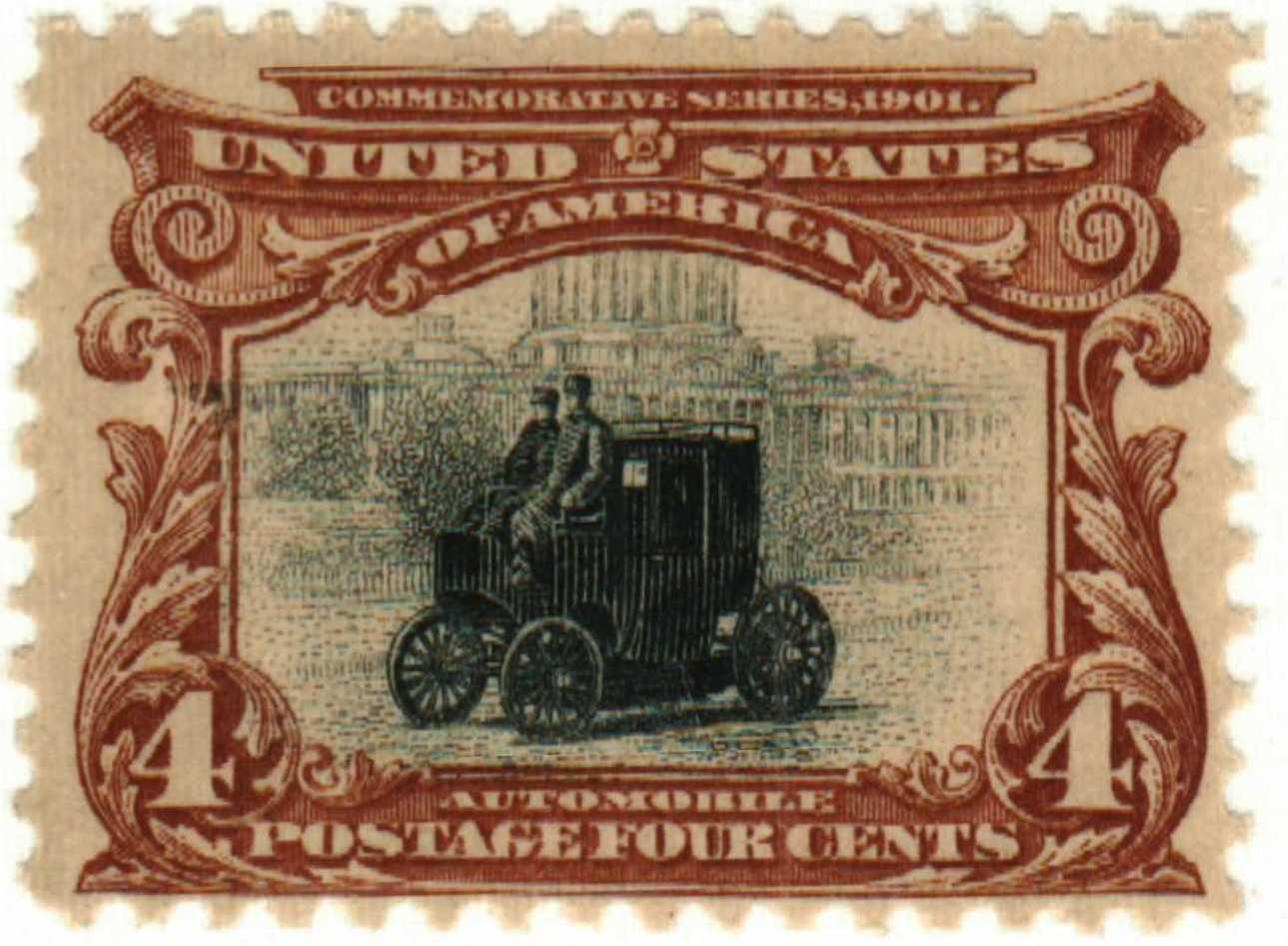
# 296 - 1901 4c Pan-American Exposition: Electric Automobile
1901 4¢ Pan-American Commemorative
Issue Date: May 1, 1901
Quantity issued: 5,737,100
Printed by: Bureau of Engraving and Printing
Method: Flat plate
Watermark: Double line
Perforation: 12
Color: Deep red brown and black
First New Stamps of the 20th Century
First Modern Auto Show
There had been other smaller auto shows in the US previously, even others held at Madison Square Garden. But this show is largely considered the first major, modern auto show.
The automobile industry had grown quickly in the years leading up to the show. Charles Duryea had received the first US patent for a gasoline automobile in 1895. And a year later, Henry Ford sold his first quadricycle. Horse-drawn vehicles were still the norm, and New York City public workers were removing 450,000 tons of horse manure from the streets each year.

To help bring these vehicles to the public’s attention, the Automobile Club of America sponsored a week-long auto show at New York’s Madison Square Garden. Dubbed a “horseless horse show,” the admission was 50¢ (about $70 today). Despite the high price, about 48,000 people attended the show.
Inside visitors saw a large variety of electric, steam, and “internal explosion” engines powering horseless carriages. Sixty-six different exhibitors had 160 vehicles on display. Some of them gave driving demonstrations on a 20-foot wide track that circled the exhibits. There was also a 200-foot ramp that showed the vehicles’ climbing abilities. Exhibitors put on demonstrations showing how well their cars could brake and accelerate as well.

Of all the vehicles at the show, the electric ones were the most popular, followed by steam, and then gasoline. Many exhibitors spoke of the safety of their steam-powered vehicles over the “complex and sinister” internal combustion engines. Many of these vehicles ran on “light spirits” including stove gas, kerosene, naphtha, lamp oil, benzene, mineral spirits, alcohol, and gasoline. Most were loud and vibrated erratically.

During the weeklong show, visitors had the chance to purchase the cars on display. They ranged in price from $280 ($39,300 today) to $4,000 ($561,000).
The auto show was such a success, the Automobile Club of America immediately began plans for a second show. Held one year later, it had 92 exhibits and braking and handling contests. The New York International Auto Show has been held ever since, welcoming about 1 million visitors each year. The event often includes the world debut of a number of new vehicles.

Click here for lots more stamps honoring cars.
Click here for more about the New York International Auto Show.
1901 4¢ Pan-American Commemorative
Issue Date: May 1, 1901
Quantity issued: 5,737,100
Printed by: Bureau of Engraving and Printing
Method: Flat plate
Watermark: Double line
Perforation: 12
Color: Deep red brown and black
First New Stamps of the 20th Century
First Modern Auto Show
There had been other smaller auto shows in the US previously, even others held at Madison Square Garden. But this show is largely considered the first major, modern auto show.
The automobile industry had grown quickly in the years leading up to the show. Charles Duryea had received the first US patent for a gasoline automobile in 1895. And a year later, Henry Ford sold his first quadricycle. Horse-drawn vehicles were still the norm, and New York City public workers were removing 450,000 tons of horse manure from the streets each year.

To help bring these vehicles to the public’s attention, the Automobile Club of America sponsored a week-long auto show at New York’s Madison Square Garden. Dubbed a “horseless horse show,” the admission was 50¢ (about $70 today). Despite the high price, about 48,000 people attended the show.
Inside visitors saw a large variety of electric, steam, and “internal explosion” engines powering horseless carriages. Sixty-six different exhibitors had 160 vehicles on display. Some of them gave driving demonstrations on a 20-foot wide track that circled the exhibits. There was also a 200-foot ramp that showed the vehicles’ climbing abilities. Exhibitors put on demonstrations showing how well their cars could brake and accelerate as well.

Of all the vehicles at the show, the electric ones were the most popular, followed by steam, and then gasoline. Many exhibitors spoke of the safety of their steam-powered vehicles over the “complex and sinister” internal combustion engines. Many of these vehicles ran on “light spirits” including stove gas, kerosene, naphtha, lamp oil, benzene, mineral spirits, alcohol, and gasoline. Most were loud and vibrated erratically.

During the weeklong show, visitors had the chance to purchase the cars on display. They ranged in price from $280 ($39,300 today) to $4,000 ($561,000).
The auto show was such a success, the Automobile Club of America immediately began plans for a second show. Held one year later, it had 92 exhibits and braking and handling contests. The New York International Auto Show has been held ever since, welcoming about 1 million visitors each year. The event often includes the world debut of a number of new vehicles.

Click here for lots more stamps honoring cars.
Click here for more about the New York International Auto Show.



















